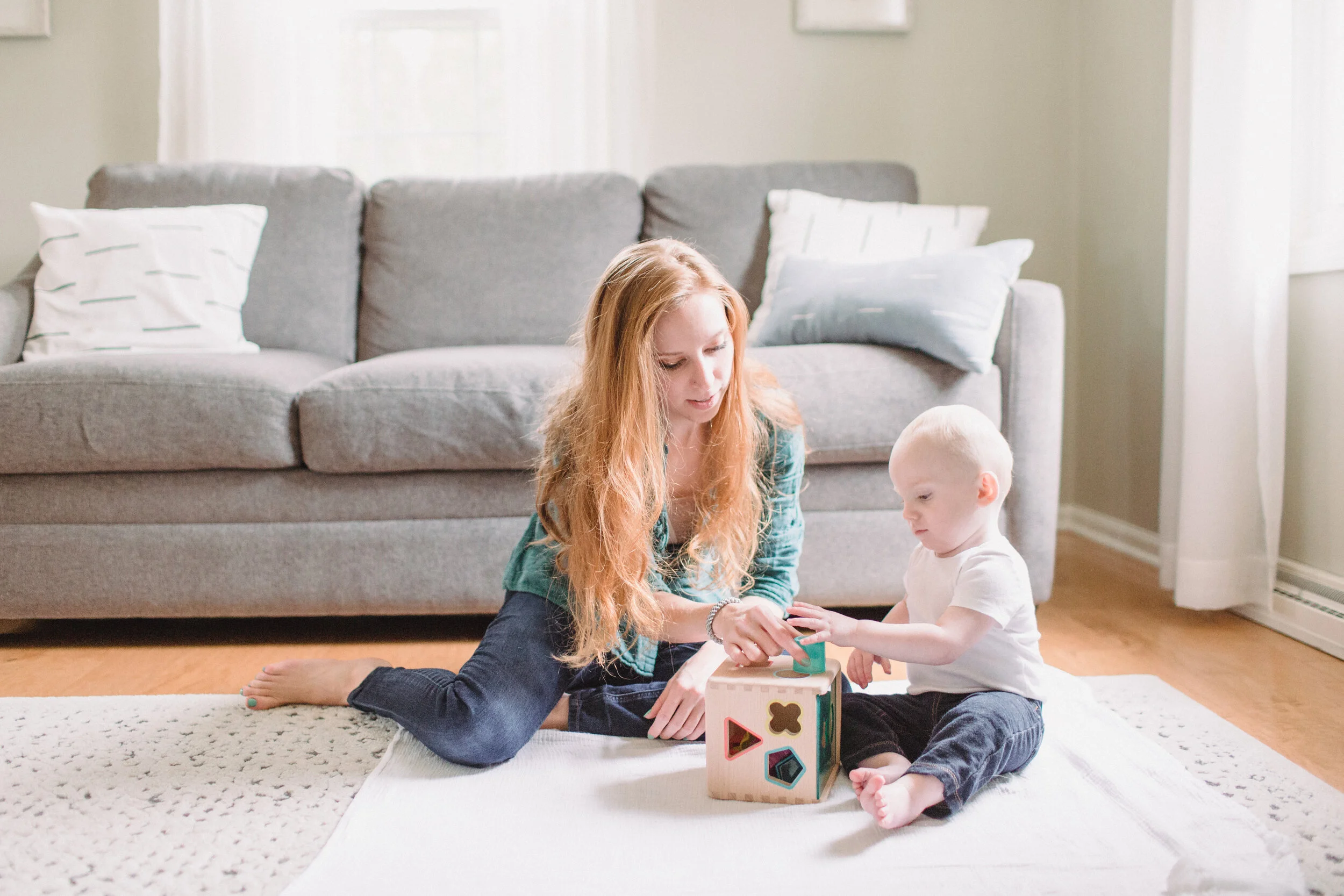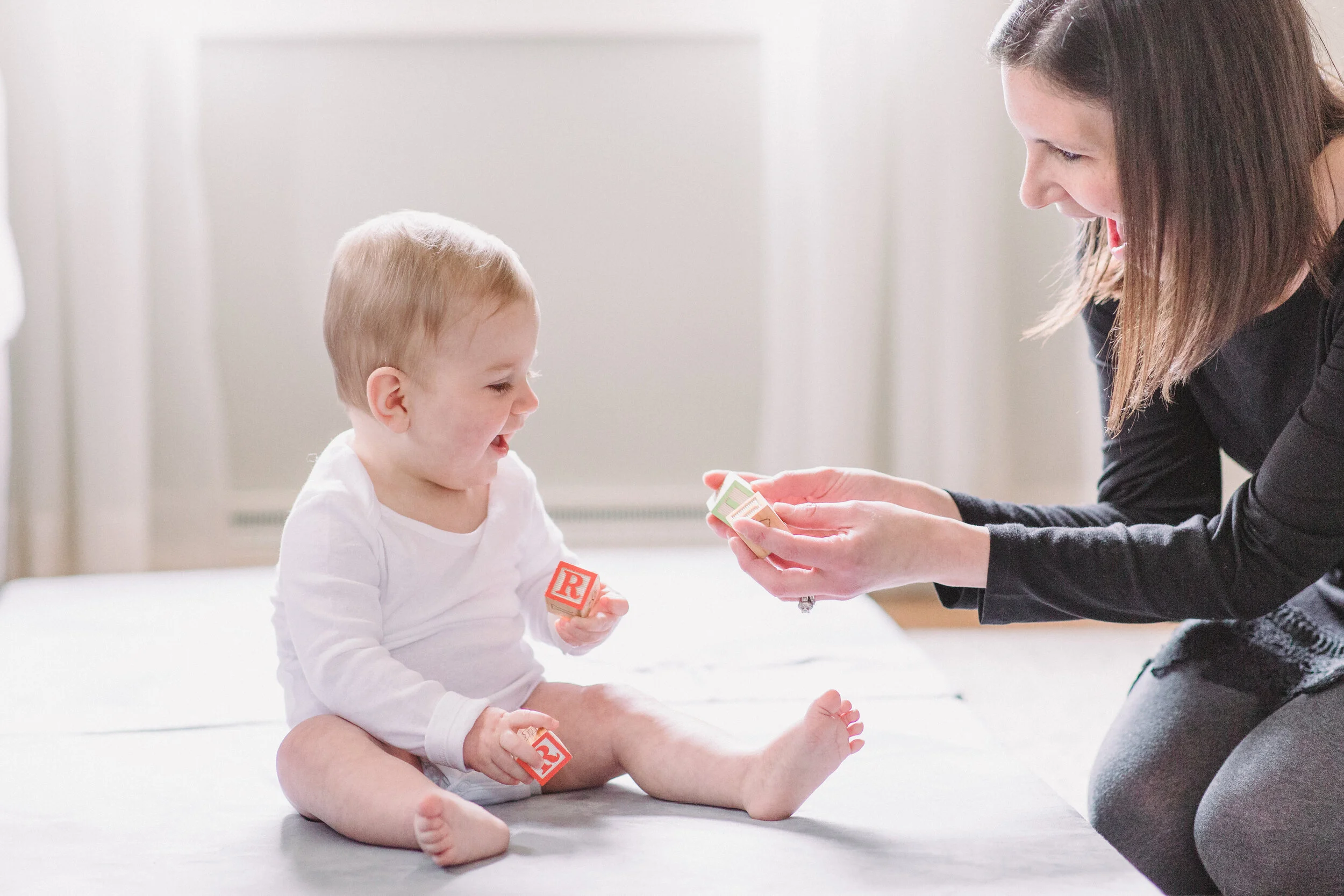Hand skills develop through experience and trial and error learning. They affect how we interact with the world, play, feed ourselves, write, get dressed and can even affect language skills. More info here on hand development through the first year and how to use play to help promote it.
How to Encourage Your Baby's Communication
Although you may jump right to thinking about baby’s first word when you think of communication development in the first year, there is so much that needs to develop in baby’s brain before we can expect to hear that first precious “mama” or “dada.” We use the term communication to encompass many aspects of speech and language development, including vocabulary (i.e., how many words a child says), articulation (i.e., how words are formed in the mouth), language expression (i.e., what a child says) and comprehension (i.e., what a child understands), gesture use (e.g., waving), and social skills (e.g., eye contact, turn-taking).
8 Tips for Enhancing Speech & Language Development
You’re likely already spending time each day talking, reading, and playing with your baby. Engaging and bonding with your baby with these three activities when you can throughout the day are likely all he/she will need to develop communication skills on time. But not all interactions are created equal when it comes to enhancing speech and language development. All children will develop at their own pace, but making a few small changes to how you talk to your baby can make a big impact on your child’s ability to both understand and use language when he/she is ready.
When Should My Baby Start Solids?
You’ve finally gotten the hang of feeding your newborn, first around the clock, and now at slightly longer and more predictable intervals (and hopefully not at 4am!). As with everything else in babyhood, as soon as you’re in a good routine, it’s time to start thinking about what comes next. Starting solids can be an exciting but daunting task. Considering all of the options and opinions surrounding when and how to feed your baby can lead to more questions than answers.
When to start
The American Academy of Pediatrics (AAP) recommends that babies be exclusively breastfed, with expressed breast milk or iron fortified formula as acceptable alternative options, for the first six months of life. But, you shouldn’t just look at the calendar to tell you if it’s time to start. Babies need to have mastered several gross motor and oral-motor skills prior to being introduced to solids to improve safety (i.e., reduce risk of choking) and overall tolerance of those first meals.
Why wait until at least 6 months?
Babies are born with several reflexes that help them feed and keep them safe from choking immediately at birth. One of those reflexes is the tongue-thrust reflex, which causes baby to forcefully push his/her tongue out of the mouth when something other than breast or bottle touches the lips or tongue. This means that anything that enters baby’s mouth in the front ⅓-½ will be “thrusted” or pushed out of the mouth, too. This reflex is protective to help baby avoid choking in the first months of life.
Around 4 months of age, baby will begin to integrate this tongue-thrust and reflexive sucking to develop more complex and intentional mouth movements by bringing hands and toys to his/her mouth for oral exploration. These early mouthing experiences lay the foundation for later jaw, lip, and tongue movements necessary for safe transition to solid foods. Trying to start solids before these reflexes have integrated can easily lead to baby pushing the food out of his/her mouth, fussing, or gagging.
Eating requires the body to be strong and well supported in order to support the mouth and neck for a safe swallow. Safe introduction of solids requires that the muscles of the mouth have matured to support skills beyond the sucking/suckling of infancy. Before starting solids, baby should have mastered the following gross motor and oral-motor skills:
Prerequisite gross motor skills:
Demonstrate the ability to cough and clear the airway
Hold his/her head up for long periods of time and look around the room (i.e., have good head control)
Sit unsupported briefly on the floor (i.e., have developed postural control/strength to maintain a safe position for swallowing)
Prerequisite oral-motor skills:
Bring hands and toys to mouth frequently
Move toys and fingers to the sides of the mouth (i.e., the area of the gums where molars will erupt) and chew up-and-down several times
Move tongue to both sides of the mouth to push against/explore toy while chewing
Open mouth wide in anticipation of a spoon or toy and close lips/jaw around the utensil to clear
How to set baby up for feeding success
Starting around 4-5 months, when baby starts showing interest in others eating and can sit comfortably in his/her highchair, I recommend starting to involve baby in family mealtime. Having regular opportunities to observe others and practice the prerequisite skills needed to start solids will help ease the transition once baby reaches 6 months old and you’re ready to start feeding.
Bring baby to the table frequently to get used to sitting in the high chair
Provide safe chewing toys for oral exploration. We recommend toys that are large enough not to be a choking hazard, but that have areas small enough for your baby to bring the toy to the molar area for chewing and tongue lateralization practice. Here are some of our favorites: *
Reusable soft silicone smoothie/water bottle straws: cut down to approx 4 inches or tie into a knot to shorten for baby to better be able to manipulate
Freeze small amounts of breast milk or formula in an ice cube tray and place into a silicone feeder (like in the photo below), help baby bring to side of the mouth for chewing and not just suckling in the front of the mouth.
Dip the tools above in expressed breast milk or formula so baby gets practice chewing and swallowing small amounts of liquid
Talk about the foods you’re eating and model eating to your baby
Start prepping foods and freezing now, you’ll thank yourself later!
*We participate in the Amazon Affiliates Program. If you click on a link above and buy the product , we earn a small referral fee without any additional cost to you. These products are genuinely our favorites as therapists and moms. We won’t recommend anything we haven’t tried or don’t fully stand behind.
Some babies may not be ready for solids right away when they turn 6 months old, and that is just fine too! Taking time to ensure that baby has mastered all of the skills above will mean that you are giving your baby the best and safest start to his/her feeding journey. Check back to this list every week or two, and feel confident that you are starting solids at the right time for your baby.
Use our milestone checklists to track your child’s skills and progress and always speak with your pediatrician if you are concerned about your child’s feeding skills. There are oral-motor and feeding delays and disorders that are unavoidable and require early detection and prompt intervention by a licensed SLP or OT trained in feeding.
More to come on WHAT to feed your baby starting at 6 months including links to some of our favorite dietitians who have extensive training and wonderful resources already compiled to answer more of your questions about starting solids.
Jaclyn
We’re Bree & Jaclyn
Pediatric therapists and moms with a mission to empower you with knowledge to encourage your baby’s development and continue confidently into your parenthood journey.
If you have any questions, please feel free to leave a comment below and we will get back to you. As always, the information we share is meant to provide general education and tips and is not intended as medical advice. If you have a specific question or concern about your child’s development, please speak directly to your child’s doctor or therapist.
Tummy Time Activities for Babies 0-6 Months Old
The tummy time position is important because it helps baby to strengthen the neck, back, and shoulder muscles. This strength allows baby to pick up his/her head and look around at the world. It strengthens the back muscles (those that run down the sides of the spine) so that the trunk (body) can eventually support the head and neck when moved into an upright or sitting position. Tummy time is important for all babies starting at birth to six months and beyond.










